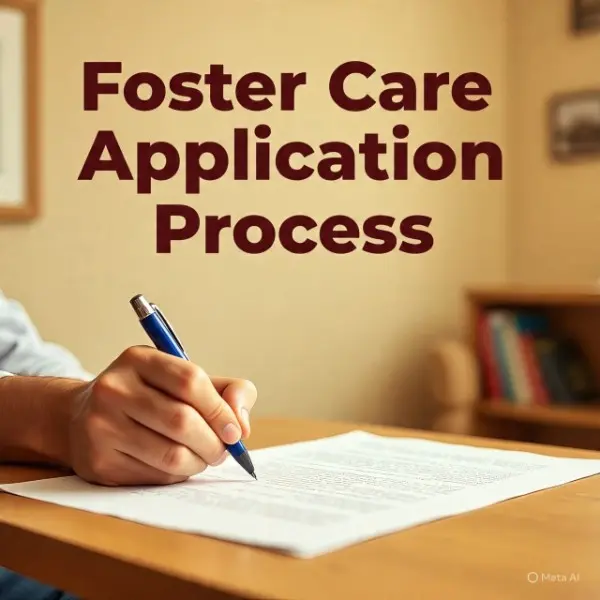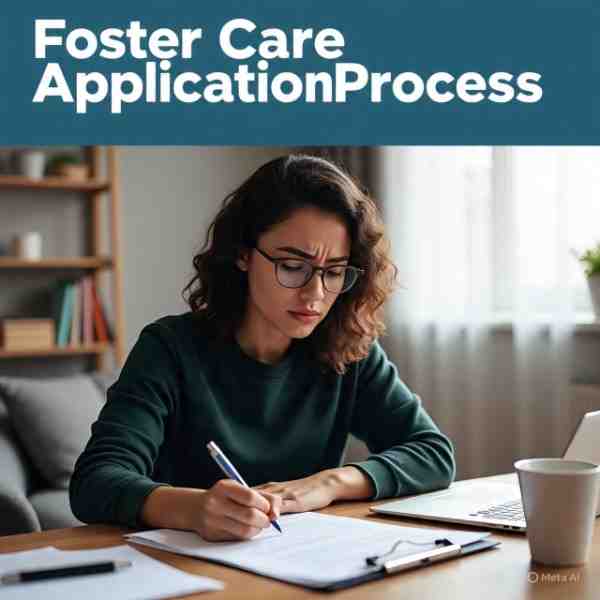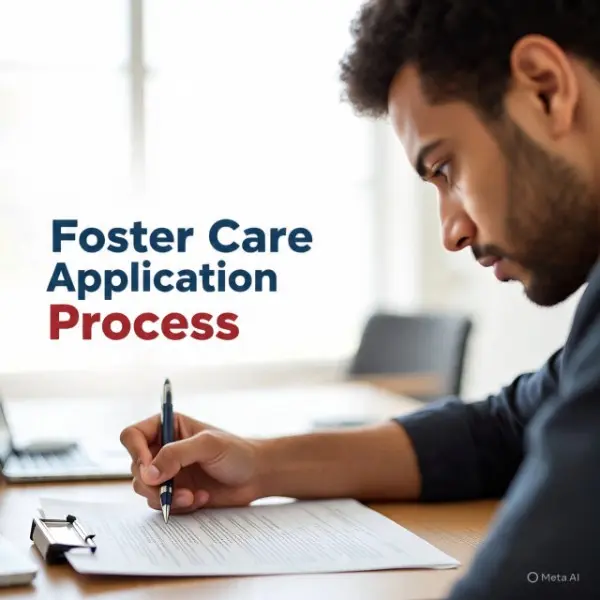7 Killer Foster Care Application Process Steps That Work Now

The foster care application is impossible and only for perfect families.” It is a long-standing myth that has kept many well-meaning individuals away from entering into foster care and has denied vulnerable children the nurturing homes that they critically deserve.
The truth is quite the opposite: while the application for foster care is a formal and lengthy procedure, it is fully attainable with the right support and preparation.
Thousands of ordinary people every year undergo this process and emerge licensed foster parents. They’re not wealthy, they live in houses but not estates, and they’re certainly not perfect.
What they all have in common is determination, a persevering spirit, and exposure to information pertinent to the procedure and the procedure only.
In this complete roadmap, you’ll uncover the 9 proven foster care application process steps that really work in the system today. These tried-and-true strategies will reveal just what you’re getting into and help you sidestep costly mistakes and ease through each phase with assurance.
Whether you’re just getting started thinking about it or you’ve already begun to explore, this blueprint will turn something that feels overwhelming into simple, doable steps toward making a life-altering impact in a child’s life.
Foster Care Application Process Step-by-Step:
1. Grasping Eligibility Before Initiating the Application:
Before entering into paperwork, it is highly important to recognize that eligibility requirements in foster care are broader than everyone assumes.
You do not necessarily have to be wealthy, married, and own a house to become a foster parent. The system is capable of recognizing that loving and stable homes are different in many ways.
Standard eligibility criteria for foster care application process involve being over the age of 21 (18 in a few states), passing background screenings, showing a stable income that is adequate to care for your household, and possessing enough space for a child.
The majority of the states demand a spare bedroom, although a few permit sharing bedrooms by the children under specific situations.
Consider Sarah, a single teacher who worried she wouldn’t qualify because she rented an apartment and had student loans.
After attending an information session, she learned that her stable employment, clean background, and genuine desire to help children made her an excellent candidate.
Note that her modest income was not a barrier, and that’s because the focus during was on stability and her ability to provide a safe, environment for the adoptee.
Each state has specific guidelines, so researching your local requirements early prevents wasted time and disappointment.
In most of the agency websites, you will see clearly outlined eligibility criteria to guide you, and many offer pre-qualification consultations to help you assess your readiness before beginning the formal process.
2. Orientation and Foster Care Information Sessions Visits:
Foster care orientation sessions serve as your introduction to the system, not a test you need to pass. These sessions provide essential education about what fostering involves, answer your questions, and connect you with experienced caseworkers who become valuable resources throughout your journey.
Many prospective parents mistakenly view orientation as an evaluation where they might say something wrong and be disqualified.
In reality, agencies want you to succeed and use these sessions to ensure you have realistic expectations about fostering’s challenges and rewards. Caseworkers appreciate engaged adoptive parents who ask interesting questions.
Start getting yourself ready for orientation by jotting down your concerns and questions ahead of time. Topics often discussed are placement expectations, support services offered, financial aid, and the situation where a placement does not work.
Do not hesitate to ask a “stupid” question—agencies hope for well-prepared applicants with a clear idea of what they are getting into.
For example, Peter and his wife, Mary, are potential fosterers, who were initially daunted by the unknowns.
After the orientation session, though, they found out that the procedure was more comprehensible than they’d anticipated it would be.
Their explanation from the caseworker about the training, support systems, and realistic timeframes assured them to move ahead. They appreciated that they found out about the experience of other families and that they weren’t the only ones who had concerns and excitement.
3. Completing the Foster Care Application Paperwork:
To succeed in your foster care application process, there must be extensive paperwork that will fully state your personal information, financial records, employment history, and references.
Although the forms sometimes seem intimidating, remember that honesty matters more than perfection. Agencies are only interested in knowing who you are, not judging you for past mistakes or current limitations.
Standard paperwork includes personal history forms, medical clearances, financial statements, employment verification, and reference contacts.
You will provide information on childhood history, relationships, views on parenting, and reasons for foster care. Some of the forms ask about prior adversity, either in financial issues, relationship challenges, or crime involvement.
Divide the paperwork into small pieces instead of doing it all at one time. Allow specific time for each form and do not hesitate to call your caseworker in case of questions.
A lot of people freeze at questions regarding personal challenges or flaws, but agencies value applicants who show awareness and development of oneself.
Most agencies guide throughout the paperwork process, recognizing that these forms represent significant time investments for applicants. Some agencies also provide workshops, empowerment programs, or individual appointments that will help you complete forms accurately and thoroughly.
Remember, this paperwork creates the foundation for your home study, so thoroughness and honesty serve you well in later stages.
4. Finalizing Background Checks and Fingerprinting:
Comprehensive safety screenings are among the requirements during foster and they are designed to protect children in care. The foster care application process includes comprehensive background checks covering criminal history, child abuse registries, and sometimes credit reports.
Having a clear understanding of all you are required to do during these background checks will help you eliminate anxiety about the foster care process.
One common misconception about applying for foster care is that any dent on your record will make the agency disqualify, but the reality, agencies evaluate backgrounds holistically, considering the nature, severity, and timing of any issues.
An old traffic ticket or minor financial mistake won’t derail your application, though serious crimes involving violence, substance abuse, or child endangerment typically do.
Background checks examine criminal records at the local, state, and federal levels.
Note that the agency will also screen you against child abuse and neglect registries. Some states require fingerprinting for FBI checks, while others use name-based searches. The process typically takes 2-6 weeks, depending on your state’s procedures and any complications that arise.
Take the case of James, who fretted that a charge of shoplifting from his youth would disqualify him from becoming a foster parent.
When he told his caseworker in the application, the caseworker praised his integrity and told him that youthful indiscretions, particularly ones that come after a long period of clean living, hardly ever disqualify candidates.
It was James’s sincerity alone that mattered during the background check, and that also helped his application, as it shows integrity and maturation.
5. Working on Home Study and Safety Evaluation:
The home study is the most in-depth component of the foster care application process, and it comprises interviews, home visits, and assessments of lifestyle. While you may have heard tales of woe about the home study, it does not involve passing judgment upon your furnishings or the perfection of housewife status.
During the home study, a caseworker will visit your home many times to interview household members, assess safety features, and understand your family dynamics.

They’ll ask about your childhood, relationships, parenting approaches, and expectations about fostering. These conversations help determine whether fostering aligns with your family’s strengths and lifestyle.
Safety assessments take into account functional elements like smoke detectors, fire extinguishers, safety storage of chemicals and medications, and acceptable sleeping arrangements.
Your home does not necessarily need to be expensive or new but it must be family-friendly and safe. Hazard-free homes where children will thrive are ideal for caseworkers.
Maria, a single parent in a small apartment, fretted that her limited space wouldn’t make it through inspection. Her caseworker reassured her that space is less important than safety and usability.
By putting in safety-recommended locks and the appropriate placement of smoke detectors, the assessment of Maria’s house passed with ease.
The caseworker pointed out that warmth in the apartment and a clear demonstration of fondness for children on Maria’s part counted more than square footage and extravagant furnishings.
6. Training and Preparation Courses for Foster Parents:
Foster parent training provides essential skills for supporting children who’ve experienced trauma, loss, and instability. Most states require 20-40 hours of pre-licensing training covering topics like child development, trauma responses, behavioral management, cultural sensitivity, and working with birth families.
Training curricula cover the special issues that foster children experience, such as attachment issues, disruption in education, and health issues.
Age-in-appropriate discipline models, identification of symptoms of trauma, and establishment of a trusting relationship with children who are guarded around adults are discussed in the curricula. Cultural competency modules educate you in serving children of a different culture from yours.
Train with a receptive mind and a spirit of challenging assumptions about parenting and the nature of children. Children in care might require a different response from biological children, and effective training challenges you to expand your horizons and skill repertoire.
The most valuable thing about training is frequently getting in touch with other prospective and long-term foster families. These networks give you ongoing encouragement, day-to-day advice, and reassurance that you’re not going through difficulties in isolation.
Lots of lifelong friends are forged in the training groups, developing networks that you find utterly priceless in the long term.
7. Securing Authorization and Placement Matching:
Immediately you complete and submit all requirements, you’ll receive your foster care license and be placed on an availability list for child placements.
The matching process is when children’s specific needs are matched with the families that are best and prepared to support them, and most times, factors like age preferences, experience levels are required to accomplish that.
Have in mind that the matching in foster care adoption process involves more than just finding available space for a child that needs placement will help you better because caseworkers consider each child’s emotional, medical, educational, and behavioral needs alongside your family’s strengths, experience, and capacity.
A good match sets everyone up for success, while poor matches can result in placement disruptions that traumatize children and discourage families.
My sincere advice to you is that you remain patient and optimistic during the matching process, as it may take some time to find the right fit for you.
The truth is that the times for matching are different based on the agency and the availability of the baby. While some families receive calls within days of approval, others may wait months for appropriate matches.
Using this waiting period as a time to prepare yourself practically and emotionally, connecting with other foster families and attending ongoing training can be the best decision to take at the moment.
David and Lisa waited four months after approval before receiving their first placement call. Initially frustrated by the delay, they later realized the wait allowed them to find the perfect match: a sibling group whose needs aligned perfectly with their experience and preferences.
The extra preparation time will enable them to feel more confident and ready when the children finally arrive, which contributes to a successful long-term placement that eventually leads to adoption.
Common Mistakes in the Foster Care Application Process:
Preventable errors by well-meaning applicants cause them delays or a more complex foster care application process. Knowing the traps helps you sidestep avoidable delays and frustrations.
Trying to hurry through paperwork without close attention almost always causes issues in the future. Blank forms, undated signatures, or unresponsive answers demand a follow-up that prolongs the processing time.
Carefully take your time filling in the forms and ask for clarification where necessary instead of guessing the requirements.
Covering up past errors rather than being honest almost always backfires. Background checks uncover most problems in any case, and lying raises concerns about your integrity.
Agents value candidates who admit past difficulties but show growth and consistency. Your candor about adversity demonstrates self-awareness and integrity.
It’s not that important to make your home “too perfect” as that may actually hurt you in the long run. The most important thing is that the kids feel at ease in actual homes and not in museum-quality displays.
Prioritize safety and warmth instead of wowing caseworkers with fancy pieces or perfect organization that kids will be too scared to mess with.
Do not neglect self-care while you are waiting for approval, as that can leave you emotionally drained when children arrive. The application process is stressful and time-consuming, but maintaining your physical and mental health ensures you’re ready to support children effectively when placements begin.
Practical Steps for the Simplification of the Procedure:
When you plan and get yourself ready before the background check you will not have much stress throughout the foster care application process. These effective approaches assist you in getting through demands promptly and maintaining momentum towards the goal.
Create a detailed timeline for each application step, working backward from your desired completion date. Build in buffer time for delays, document gathering, and scheduling appointments. Having clear milestones helps you track progress and identify potential bottlenecks before they become major problems.
Incorporate a support system before starting the process. Family and friends provide encouragement, tangible support, and perspective in the tough times. Perhaps consider reaching out to other foster families that will be able to share insight from the basis of having been through the system.
Keep a special folder or binder with all paperwork and keep copies of everything submitted. Staying organized will prevent you from the stress of looking for paperwork when changes or clarifications are needed. Online copies of paperwork safely stored grant you backup access in the event of lost or destroyed originals.
Maintain frequent communications with your caseworker at all times. Raise issues at an early stage, reply promptly to requests for information, and let them know of changes in situations. Responsive applicants who turn out to be reliable make a favorable impression and facilitate ease of processing.
Reward small achievements along the way and not at the grant of final approval. Training completion, passing the home study, or receiving background check clearance are each major accomplishments deserving of celebration. Celebrating achievements helps keep the momentum going through long delays.
How long does the foster care application process take?
The complete process typically takes 3-9 months, depending on your state’s requirements, how quickly you complete paperwork and training, and scheduling availability for home studies and background checks.
Can single people apply to be foster parents? Absolutely! Thousands of successful foster parents are single. Agencies focus more on your stability, commitment, and ability to provide safe, nurturing care rather than your marital status.
Do I need to own a home to qualify?
Absolutely not, it doesn’t matter if you own a house or not. Renters can foster as long as they have adequate space, landlord permission, and stable housing situations that meet safety requirements.
What can disqualify someone from fostering?
Some of the things that can be a stumbling block to your being a foster parent are serious criminal convictions involving violence, child abuse, or sexual offenses, which can disqualify any applicant.
Substance abuse issues, recent domestic violence, or inability to provide a safe environment also prevent approval
What does the application process cost?
The majority of application processes are free of charge but you might pay for a medical exam, CPR certification, or background check. Certain states refund the costs of each upon completion.
Can I adopt through the foster care system if I choose to?
Yes, many foster children are freed for adoption when reunion with the birth family is not an option. Foster parents are frequently given first priority in considering the adoption of children in the system.
What assistance is provided after licensure?
Licensure-eligible foster families are usually provided with monthly reimbursement of funds, in-service training opportunities, options for respite care, and casework support with issues arising in the placement situation.






